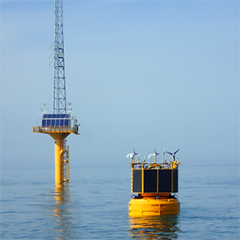During a recent two week offshore operation, FLiDAR chartered one vessel to serve three clients.
The Pole Star began its journey in Oban, Scotland, first sailing to the NAREC met mast to pick up one of the FLiDAR buoys which had just finished a successful post validation campaign for Mainstream Renewable Power’s Neart na Gaoithe project, completing a successful wind measurement campaign. In less than a day the buoy and the double mooring system had been collected.
David Sweenie , Project Manager at Mainstream Renewable Power said: “Collaboration is a key contributor to reducing cost, and we are delighted with FLiDAR’s approach to managing their vessels between clients. The equipment was retrieved safely and quickly, concluding a very successful campaign.”
The vessel then sailed to Fécamp in Northern France where the buoy was deployed offshore next to the recently installed met mast of the future offshore windfarm of Fécamp. The buoy is undergoing a pre-validation, after which it will be moved to carry out a measurement campaign on the proposed Calvados offshore wind farm site. The entire deployment operation took no more than 10 hours.
The Pole Star then set sail for the Irish Sea for its third and final task. The FLiDAR buoy owned by DONG Energy was moved from its measurement position on Walney Extension offshore wind farm to the West of Duddon Sands met mast for a validation period. The collection of the buoy and mooring was done in one day and redeployed the following day. The hours in between were sufficient for some rapid preventive maintenance on the buoy while it was still on board of the vessel.
The project manager at DONG Energy said: “As always FliDAR NV provided us with a safe and reliable operation offshore to relocate the FLiDAR buoy to the WDS met mast. We are very happy with the fact that FLiDAR NV are maximising the synergies between their clients to reduce costs and to all involved. The continued use of the Pole Star allows for the crew of the vessel to increase their familiarity with handling the FLiDAR buoys therefore reducing the risks of working with these units offshore.”
The combined operation significantly reduced the costs, which were divided between the three clients. FLiDAR staff were present during each intervention, making sure the buoys were fully operational before deployment.
Reinhardt Stevens, General Manager at FLiDAR said: “We always try to optimise all our activities, not only on the product side, but also on the operations. We are delighted to be able to work together with our clients to help reduce costs and increase operational efficiencies.”
The FLiDAR technology has been developed by 3E, global renewable energy consultancy and software provider, and Offshore & Wind Assistance (OWA), the subsidiary of marine contractor Geosea.
The FLiDAR equipment consists of an industry standard Mobilis buoy equipped with a state-of-the-art buoy-adapted LEOSPHERE WINDCUBE®v2 LiDAR held in a passive mechanical stabilisation system. It has previously been tested and validated against fixed met masts in the North Sea and in Irish Sea (as part of the UK’s Carbon Trust Offshore Wind Accelerator programme). The performance has been analysed and validated by third parties and has been proven to deliver wind data with accuracy equivalent to standard offshore wind measurements. FLiDAR has reached Stage 2 on the Carbon Trust roadmap as first floating LiDAR supplier.
About FLiDAR
FLiDAR N.V., based in Oostende, Belgium, is a joint venture established in August 2012 between 3E and OWA (DEME group), to build, deploy and operate floating LiDAR based measurement devices.
FLiDAR N.V. combines the experience of 3E, an independent consultant and software services provider with more than 10 years of experience in offshore wind measurement and modelling, OWA, a daughter company of DEME, an offshore contractor with huge amount of experience in offshore operations, LEOSPHERE, the world’s leading manufacturer of LiDAR technology and Mobilis, a buoy supplier with a track record of manufacturing and deploying buoys for long periods in extreme offshore locations.
The FLiDAR device can measure wind potential up to 200m above mean sea level with accuracy equivalent to a standard offshore measurement mast, but at significantly lower costs.
www.FLiDAR.com






























